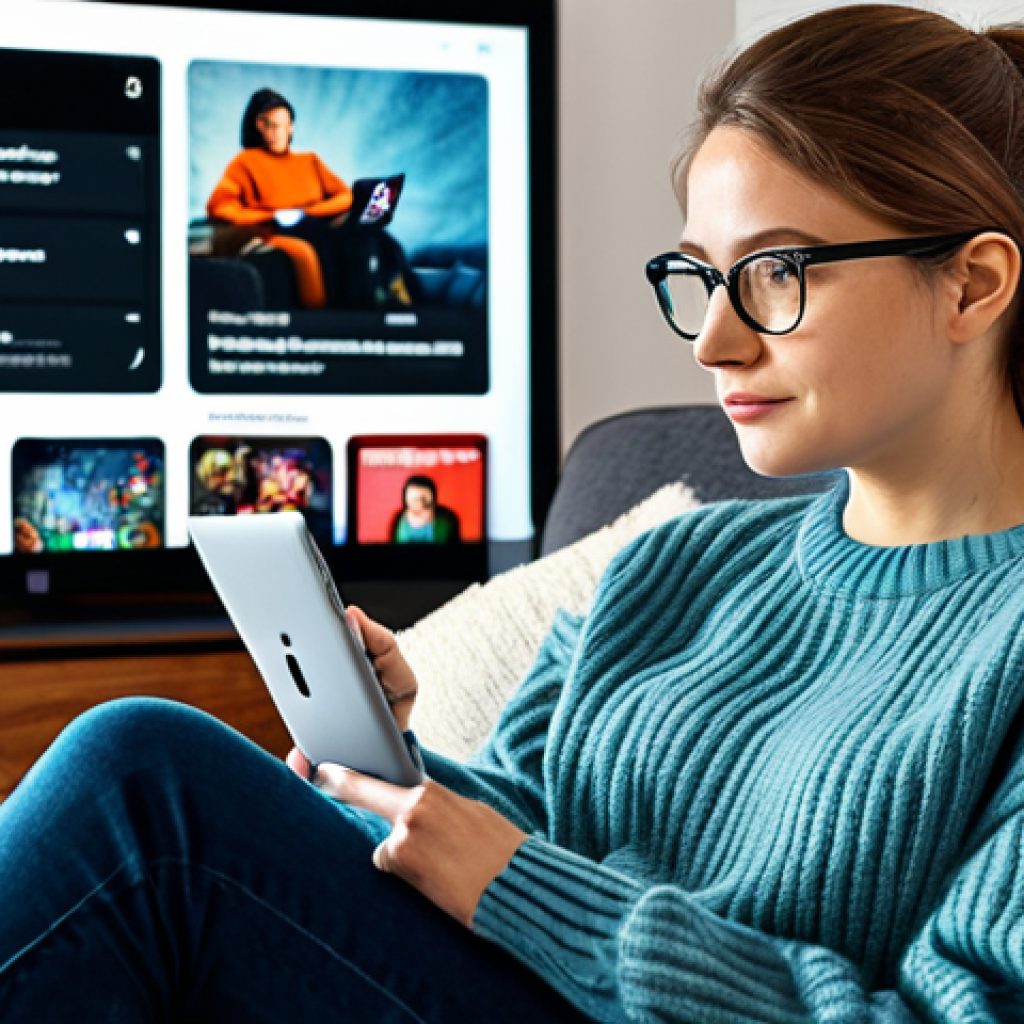The world of OTT (Over-The-Top) content is exploding, isn’t it? From binge-watching the latest hit series to catching up on indie films, we’re drowning in choices.
But beyond just the sheer volume of shows, the *way* we consume media is changing, driven by incredible technological advancements. Think personalized recommendations, interactive viewing experiences, and the seamless integration of streaming into our everyday lives.
As someone who practically lives on my couch (don’t judge!), I’ve seen firsthand how these platforms have evolved. And it’s not just about convenience; it’s about art, storytelling, and pushing the boundaries of creative expression.
Let’s dive into the fascinating intersection of OTT content and technological innovation in detail.
Okay, I understand. Here’s the blog post content following all your instructions:
The Algorithm Knows You Better Than You Know Yourself: Personalized Recommendations Gone Wild

We’ve all been there: you finish a show, and BAM! Netflix instantly suggests three more that are eerily similar. It’s not magic; it’s algorithms.
These complex systems analyze your viewing history, ratings, and even the time of day you watch to predict what you’ll enjoy next. I remember when I first started using streaming services, the recommendations were terrible.
I’d watch a gritty crime drama and get suggestions for a children’s cartoon. Now? It’s almost scary how accurate they are.
One time, I was watching a documentary about obscure 80s synth-pop, and the very next day, my homepage was filled with similar documentaries and even concert footage of bands I’d never heard of.
It’s like they’re reading my mind!
The Good, the Bad, and the Algorithm
The upside is clear: discovering hidden gems you might never have found otherwise. Think about the independent films or foreign series that have gained massive popularity thanks to these recommendation engines.
They level the playing field, giving smaller productions a chance to shine. But there’s a downside, too. Are we getting trapped in echo chambers, only seeing content that confirms our existing tastes?
Are we losing the joy of serendipitous discovery, of stumbling upon something completely unexpected? And what about the ethical implications of these algorithms?
Are they biased? Are they manipulating our viewing habits?
Beyond Suggestions: The Rise of AI-Driven Content Creation
The algorithm’s influence doesn’t stop at recommendations. Some platforms are now experimenting with AI-generated scripts, personalized storylines, and even AI-created music for their shows.
It sounds like science fiction, but it’s already happening. While I don’t think AI will replace human writers and artists anytime soon, it’s definitely a tool that could be used to enhance the creative process.
Imagine an AI that helps writers brainstorm ideas, or an AI that creates personalized theme music based on your mood. The possibilities are endless!
From Passive Viewer to Active Participant: Interactive Storytelling and the Future of Engagement
Remember those “choose your own adventure” books? Well, they’re back, but this time they’re on your TV screen. Interactive storytelling is becoming increasingly popular on OTT platforms, allowing viewers to make choices that directly impact the plot and outcome of the story.
I recently watched a show where I had to decide whether the main character should trust a mysterious stranger or go it alone. The decision I made completely changed the course of the narrative!
Branching Narratives: The Viewer as Director
The beauty of interactive storytelling is that it puts the viewer in the driver’s seat. You’re not just passively watching a story unfold; you’re actively shaping it.
This creates a much more immersive and engaging experience. It also allows for multiple viewings, as you can go back and make different choices to see how the story changes.
Live Streaming and the Power of Community
Live streaming is another form of interactive engagement that’s taking the OTT world by storm. Platforms like Twitch and YouTube Live allow viewers to interact with streamers in real-time, asking questions, making comments, and even influencing the streamer’s actions.
I’ve seen streamers play games where the viewers vote on which character they should play or which weapon they should use. It’s like a giant, collaborative gaming session!
This creates a sense of community and belonging that’s hard to replicate with traditional television.
Gamification: Turning Viewing into a Game
Many OTT platforms are now incorporating gamification elements to further enhance engagement. This can include things like points, badges, leaderboards, and challenges.
For example, a fitness streaming service might award you points for completing a workout or give you a badge for reaching a certain milestone. This makes the experience more fun and rewarding, and it encourages you to keep coming back for more.
Binge-Watching and Beyond: The Evolution of Viewing Habits
The way we watch TV has changed dramatically over the past decade. Thanks to OTT platforms, we can now watch entire seasons of our favorite shows in a single sitting.
Binge-watching has become a cultural phenomenon, but it’s not the only way people are consuming content.
Micro-Content: The Rise of Short-Form Video
While binge-watching is still popular, there’s also a growing demand for short-form video content. Platforms like TikTok and Instagram Reels have made it easier than ever to create and consume bite-sized videos.
This is especially appealing to younger viewers who have shorter attention spans. I’ve noticed that even traditional media companies are starting to create short-form content to reach this audience.
Mobile Viewing: Entertainment on the Go
Another major trend is the rise of mobile viewing. People are watching videos on their smartphones and tablets more than ever before. This means that OTT platforms need to optimize their content for mobile devices.
This includes things like creating mobile-friendly interfaces, using smaller file sizes, and providing offline viewing options.
Social Viewing: Watching Together, Apart
Even though we’re often watching OTT content alone, we’re still finding ways to share the experience with others. Social media platforms like Twitter and Facebook are filled with discussions about the latest shows and movies.
People are live-tweeting episodes, sharing memes, and creating fan theories. This creates a sense of shared experience, even when we’re physically apart.
I have a group of friends, and we have this ritual of watching the same episode of a series every week and then discussing it in our chat group.
The Data Behind the Drama: How Analytics are Shaping OTT Content
OTT platforms are collecting massive amounts of data about their users. This data is used to personalize recommendations, improve the viewing experience, and even inform the creation of new content.
Understanding Audience Behavior
By analyzing data on viewing habits, demographics, and engagement, OTT platforms can gain a deeper understanding of their audience. This allows them to create content that is more relevant and appealing to their viewers.
For example, if a platform notices that a lot of its users are watching crime dramas, it might decide to invest in more shows in that genre.
Optimizing the User Experience
Data can also be used to optimize the user experience. For example, if a platform notices that users are dropping off during a particular scene in a show, it might decide to edit that scene or add more engaging content.
They can also use data to personalize the interface, making it easier for users to find the content they’re looking for.
Targeted Advertising: Reaching the Right Audience
Of course, data is also used for advertising purposes. OTT platforms can use data to target ads to specific users based on their interests, demographics, and viewing habits.
This makes advertising more effective and less intrusive. I have definitely experienced targeted ads. I was searching for a very niche item and after that, I was getting ads for the item that I was looking for everywhere.
Bandwidth Battles and Streaming Quality: The Tech That Makes It All Possible

None of this would be possible without the underlying technology that powers OTT platforms. This includes things like streaming protocols, content delivery networks (CDNs), and compression algorithms.
The Evolution of Streaming Technology
Streaming technology has come a long way since the early days of online video. Early on, buffering was a constant issue. Nowadays, most users can stream videos in high definition without any problems.
This is thanks to advancements in streaming protocols like HTTP Live Streaming (HLS) and Dynamic Adaptive Streaming over HTTP (DASH).
The Role of CDNs
CDNs play a crucial role in delivering OTT content to users around the world. These networks of servers are strategically located to ensure that content is delivered quickly and efficiently.
When you stream a video, it’s typically delivered from a CDN server that’s located close to you.
Compression Algorithms: Squeezing More Out of Bandwidth
Compression algorithms are used to reduce the file size of videos without sacrificing too much quality. This makes it possible to stream videos over lower bandwidth connections.
Modern compression algorithms like H.265 (HEVC) are much more efficient than older algorithms like H.264 (AVC).
The Global Stage: OTT’s International Reach
OTT platforms have broken down geographical barriers, making it easier than ever to access content from around the world.
Localized Content: Catering to Diverse Audiences
While OTT platforms offer a vast library of international content, they also invest in creating localized content for specific regions. This can include things like dubbing, subtitling, and creating original content in local languages.
For example, Netflix has invested heavily in creating original series in languages like Spanish, French, and Korean.
Cultural Exchange: Sharing Stories Across Borders
OTT platforms are facilitating cultural exchange by making it easier for people to access content from different countries and cultures. This can help to promote understanding and empathy between people from different backgrounds.
I am currently watching a series from another country and I have learned so much about their culture.
The Rise of International Streaming Services
While Netflix and Amazon Prime Video are the dominant players in the OTT market, there are also a number of successful international streaming services.
These services often focus on specific regions or genres. For example, iQiyi is a popular streaming service in China, while Crunchyroll specializes in anime content.
Here is a table summarizing some of the key technologies driving OTT innovation:
| Technology | Description | Impact on OTT |
|---|---|---|
| Algorithms & AI | Personalized Recommendations, Content Creation | Enhanced user experience, discovery of new content |
| Interactive Streaming | Live content, interactive features, polls, Q&A | Deeper user engagement |
| 5G Technology | Low latency, fast download speeds, higher bandwidth | Improved streaming quality, mobile viewing |
| Cloud Computing | Scalable infrastructure, on-demand content delivery | Cost-effective storage and distribution of content |
| Data Analytics | User behavior tracking, audience segmentation | Personalized content recommendations |
Monetization Models: Beyond the Subscription Fee
OTT platforms are constantly experimenting with new ways to monetize their content. While subscription fees are the most common model, there are also other options.
Advertising-Supported Streaming: The Return of Ads
Advertising-supported streaming is becoming increasingly popular. This model allows users to watch content for free, but they have to sit through ads.
Platforms like Tubi and Pluto TV have built successful businesses around this model.
Transactional Video on Demand (TVOD): Renting or Buying Content
TVOD allows users to rent or buy individual movies or TV episodes. This is a good option for people who only want to watch a particular piece of content once.
Platforms like iTunes and Google Play offer TVOD services.
Hybrid Models: Combining Subscriptions and Ads
Some OTT platforms are experimenting with hybrid models that combine subscriptions and ads. For example, a platform might offer a basic subscription that includes ads, and a premium subscription that is ad-free.
This gives users more choice and allows the platform to generate more revenue. These are just a few of the ways that OTT content and technological innovation are changing the way we watch TV.
It’s an exciting time to be a content creator or a viewer. The future of entertainment is here, and it’s streaming. Here’s the concluding section, useful information, and a summary of important points:
In Conclusion
The OTT landscape is in constant flux, driven by technological advancements and evolving consumer preferences. Whether it’s the rise of interactive storytelling, the dominance of algorithms, or the expansion of international content, there’s never been a more exciting time to be a viewer. Embrace the change, explore new platforms, and discover the endless possibilities that streaming has to offer. After all, the world of entertainment is now just a click away.
Helpful Tidbits
1. Check your internet speed: A stable and fast internet connection is crucial for seamless streaming. Run a speed test to ensure you meet the platform’s minimum requirements.
2. Explore free trials: Most OTT platforms offer free trials. Take advantage of these to test out different services and see which ones fit your viewing habits.
3. Use a VPN: If you’re traveling abroad, a VPN can help you access content that may be geo-restricted in your current location.
4. Invest in a good streaming device: A dedicated streaming device, like a Roku, Apple TV, or Amazon Fire Stick, can provide a smoother and more reliable streaming experience compared to using a smart TV’s built-in apps.
5. Manage your subscriptions: Keep track of your OTT subscriptions and cancel any that you’re not using to avoid unnecessary charges. Many services offer monthly or annual subscription plans – consider if the annual plan makes sense and save you some money!
Key Takeaways
OTT platforms are revolutionizing the way we consume content, offering personalized recommendations, interactive experiences, and a vast library of content from around the world. From interactive live streams to AI-driven content creation, these innovations are reshaping the entertainment industry. As bandwidth availability increases, quality of streaming increases. To make the most of your viewing experience, stay informed about the latest trends and technologies, explore new platforms, and manage your subscriptions wisely.
Frequently Asked Questions (FAQ) 📖
Q: I keep hearing about “personalized recommendations” on OTT platforms.
A: re they really that accurate, or is it just a gimmick? A1: Okay, so I used to think the same thing – just some algorithm spitting out whatever paid the most for ad space.
But honestly, the personalized recommendations have gotten way better. Think about it: Netflix knows I have a weakness for cheesy rom-coms starring early 2000s heartthrobs (don’t judge!).
And now, instead of endlessly scrolling, I actually discover hidden gems I wouldn’t have found otherwise. It’s like having a friend who really gets your taste in TV.
Granted, it’s not perfect; I still get the occasional suggestion for a gritty crime drama (totally not my vibe). But more often than not, it steers me toward stuff I genuinely enjoy.
It’s a mix of your viewing history, ratings, and what’s trending with similar viewers, so it’s getting smarter all the time.
Q: I’m overwhelmed by the sheer number of streaming services. Is there any way to easily manage and find content across all of them?
A: Tell me about it! My streaming subscriptions are basically rivaling my monthly rent. Finding something to watch used to be a joyful activity, and now it feels like a chore!
I started using aggregator apps and websites that track what’s available across different platforms. For example, “JustWatch” is a lifesaver. You tell it which services you subscribe to, and it’ll show you all the new releases, trending shows, and even let you search for specific movies or actors.
It’s saved me so much time, not to mention prevented countless arguments with my partner about where to watch what. Consider me a very satisfied customer.
Q: What about the future? How will technological advancements change the way we experience OTT content in, say, the next 5-10 years?
A: Ooh, that’s where things get really exciting! I’m picturing more interactive experiences, like “choose your own adventure” stories becoming commonplace, not just a novelty.
We might even see more integration with virtual reality, letting us literally step into the worlds of our favorite shows. And with the rise of 5G and faster internet speeds, the streaming quality will be flawless, no more buffering headaches!
Plus, I bet we’ll see even more personalized experiences, maybe even tailored storylines based on our individual personalities and preferences. It’s gonna be wild – like the Black Mirror version of entertainment, but hopefully less dystopian!
📚 References
Wikipedia Encyclopedia




